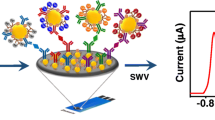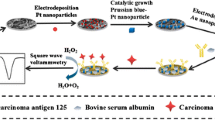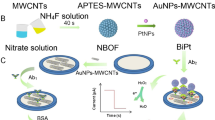Abstract
We describe the use of porous platinum nanoparticles (pPt NPs) and PdPt nanocages (PdPt NCs) in an electrochemical immunoassay for two tumor markers (CEA and AFP) directly in serum and with enhanced detection performance. The pPt NPs possess a high specific surface area and electrical conductivity, while the PdPt NCs display excellent catalytic property and high loading capacity. The PdPt NCs were labeled with anti-CEA and thionine, and the PdPt NCs were labeled with anti-AFP and ferrocene. The resulting electrode displayed a large decrease of the anodic peak current and an increase of cathodic peak current for hydrogen peroxide (H2O2). The dual square wave voltammetric immunoassay was performed at −0.1 V (for CEA) and +0.6 V (for AFP) after exposure to a sample containing CEA and AFP and in the presence of H2O2. CEA can be detected in the 0.05 to 200 ng mL−1 concentration range and AFP between 0.03 and 100 ng mL−1. The limits of detection are 1.4 pg mL−1 for CEA and 1 pg mL−1 for AFP (at an SNR of 3). The sensitivity of the method (expressed as slope vs. concentration) is better by a factor of 4.6 to 100 compared to conventional electrochemical immunoassays. Analytical data obtained with diluted serum samples were in good agreement with reference values obtained via a standard ELISA. Negligible cross-reactivity is found between CEA and AFP. In our opinion, this approach paves the way for developing other kinds of electrochemical immunosensors based on the use of pPt NPs and PdPt NCs as materials for designing new electrode interfaces.

Porous platinum nanoparticles and PdPt nanocages were prepared and used to fabricate an ultrasensitive electrochemical immunosensor for simultaneous detection of dual tumor markers with the sensitivity of ~19.9 μA (ng mL−1)−1, which is two orders of magnitude better than that of other electrode constructed mode.






Similar content being viewed by others
References
Ogaidi IA, Aguilar ZP, Suri S, Gou HL, Wu NQ (2013) Dual detection of cancer biomarker CA125 using absorbance and electrochemical methods. Analyst 138:5647–5653
Yang MH, Gong SQ (2010) Immunosensor for the detection of cancer biomarker based on percolated grapheme thin film. Chem Commun 46:5796–5798
Liu N, Wang ZF, Ma ZF (2014) Platium porous nanoparticles for the detection of cancer biomarkers: what are the advantages over existing techniques? Bioanalysis 6:903–905
Li JP, Li SH, Yang CF (2012) Electrochemical biosensors for cancer biomarker detection. Electroanalysis 24:2213–2229
Hu M, Yan J, He Y, Lu HT, Weng LX, Song SP, Fan CH, Wang LH (2009) Ultrasensitive, multiplexed detection of cancer biomarkers directly in serum by using a quantum dot-based microfluidic protein chip. ACS Nano 4:488–494
Lai WQ, Zhuang JY, Tang J, Chen GN, Tang DP (2012) One-step electrochemical immunosensing for simultaneous detection of two biomarkers using thionine and ferrocene as distinguishable signal tags. Microchim Acta 178:357–365
Pandey B, Demchenko AV, Stine KJ (2012) Nanoporous gold as a solid support for protein immobilization and development of an electrochemical immunoassay for prostate specific antigen and carcinoembryonic antigen. Microchim Acta 179:71–81
Feng DX, Lu XC, Dong X, Ling YY, Zhang YZ (2013) Label-free electrochemical immunosensor for the carcinoembryonic antigen using a glassy carbon electrode modified with electrodeposited Prussian blue, a graphene and carbon nanotube assembly and an antibody immobilized on gold nanopriticles. Microchim Acta 180:767–774
Zhao YJ, Zhao XW, Pei XP, Hu J, Zhao WJ, Chen BA, Gu ZZ (2009) Multiplex detection of tumor markers with photonic suspension array. Anal Chim Acta 633:103–108
Wang J, Cao Y, Xu YY, Li GX (2009) Colorimetric multiplexed immunoassay for sequential detection of tumor markers. Biosens Bioelectron 25:532–536
Long Y, Zhang ZL, Yan XM, Xing JC, Zhang KY, Huang JX, Zheng JX, Li W (2010) Multiplex immunodetection of tumor markers with a suspension array built upon core-shell structured functional fluorescence-encoded microspheres. Anal Chim Acta 665:63–68
Guo ZY, Hao TT, Du SP, Chen BB, Wang ZB, Li X, Wang S (2013) Multiplex electrochemiluminescence immunoassay of two tumor markers using multicolor quantum dots as labels and grapheme as conducting bridge. Biosens Bioelectron 44:101–107
Song SP, Qin Y, He Y, Huang Q, Fan CH, Chen HY (2010) Functional nanoprobes for ultrasensitive detection of biomolecules. Chem Soc Rev 39:4234–4243
Swierczewska M, Liu G, Lee S, Chen XY (2012) High-sensitivity nanosensors for biomarker detection. Chem Soc Rev 41:2641–2655
Bauza MC, Ibanez GA, Tauler R, Olivieri AC (2012) Sensitivity equation for quantitative analysis with multivariate curve resolution-alternating least-squares: theoretical and experimental approach. Anal Chem 84:8697–8706
Zeng Q, Cheng JS, Tang LH, Liu XF, Liu YZ, Li JH, Jiang JH (2010) Self-assembled grapheme-enzyme hierarchical nanostructures for electrochemical biosensing. Adv Funct Mater 20:3366–3372
Chen D, Li JH (2012) Graphene oxide: preparation, functionalization, and electrochemical applications. Chem Rev 112:6027–6053
Wang Y, Zhang S, Li ZH, Wang J, Li JH, Lin YH (2011) Self-assembly of acetylcholinesterase on a gold nanoparticles-graphene nanosheet hybrid for organophosphate pesticide detection using polyelectrolyte as a linker. J Mater Chem 21:5319–5325
Zhang JT, Li CM (2012) Nanoporous metals: fabrication strategies and advanced electrochemical applications in catalysis, sensing and energy systems. Chem Soc Rev 41:7016–7031
Giribabu K, Suresh R, Manigandan R, Kumar SP, Muthamizh S, Munusamy S, Narayanan V (2014) Preparation of nitrogen-doped reduced graphene oxide and its use in a glassy carbon electrode for sensing 4-nitrophenol at nanomolar levels. Microchim Acta 181:1863–1870
Gao W, Sattayasamitsathit S, Orozco J, Wang J (2011) Highly efficient catalytic microengines: template electrosynthesis of polyaniline/platinum microtubes. J Am Chem Soc 133:11862–11864
Yabutani T, Waterhouse GIN, Waterhouse DXS, Metson JB, Iinuma A, Thuy LTX, Yamada Y, Takayanagi T, Motonaka J (2014) Facile synthesis of platinum nanoparticle-containing porous carbon, and their application to amperometric glucose biosensing. Microchim Acta 181:1871–1878
Ponrouch A, Garbarino S, Bertin E, Andrei C, Botton GA, Guay D (2012) Highly porous and preferentially oriented {100} platinum nanowires and thin films. Adv Funct Mater 22:4172–4181
Teng XW, Liang XY, Maksimuk S, Yang H (2006) Synthesis of porous platinum nanoparticles. Small 2:249–253
Pascricha R, Bala T, Birdar AV, Umbarkar S, Sastry M (2009) Synthesis of catalytically active porous platinum nanoparticles by transmetallation reaction and proposition of the mechanism. Small 5:1467–1473
Mahmoud MA, Saira F, EI-Sayed MA (2010) Experimental evidence for the nanocage effect in catalysis with hollow nanoparticles. Nano Lett 10:3764–3764
Carpenter MK, Moylan TE, Kukreja RS, Atwan MH, Tessema MM (2012) Solvothermal synthesis of platinum alloy nanoparticles for oxygen reduction electrocatalysis. J Am Chem Soc 134:8535–8542
Zan XL, Fang Z, Wu J, Xiao F, Huo FW, Duan HW (2013) Freestanding grapheme paper decorated with 2D-assembly of Au@Pt nanoparticles as flexible biosensors to monitor live cell secretion of nitric oxide. Biosens Bioelectron 49:71–78
Zhang G, Shao ZG, Lu WT, Xie F, Qian XP, Yi BL (2013) Electrochemical preparation and characterization of PdPt nanocages with improved electrocatalytic activity toward oxygen reduction reaction. Electrochim Acta 103:66–76
Wang C, Markovic NM, Stamenkovic VR (2012) Advanced platinum alloy electrocatalysts for the oxygen reduction reaction. ACS Catal 2:891–898
Hong JW, Kang SW, Choi BS, Kim DH, Lee SB, Han SW (2012) Controlled synthesis of Pd-Pt alloy hollow nanostructures with enhanced catalytic activities for oxygen reduction. ACS Nano 6:2410–2419
Zhang H, Jin MS, Liu HY, Wang JG, Kim MJ, Yang D, Xie ZX, Liu JY, Xia YN (2011) Facile synthesis of Pd-Pt alloy nanocages and their enhanced performance for preferential oxidation of CO in excess hydrogen. ACS Nano 5:8212–8222
Khan SA, Kanchanapally R, Fan Z, Beqa L, Singh AK, Senapati D, Ray PC (2012) A gold nanocage-CNT hybrid for targeted imaging and photothermal destruction of cancer cells. Chem Commun 48:6711–6713
Kong FY, Xu BY, Xu JJ, Chen HY (2013) Simultaneous electrochemical immunoassay using CdS/DNA and phosphate buffered saline/DNA nanochains as labels. Biosens Bioelectron 39:177–182
Tang J, Tang DP, Niessner R, Chen GN, Knopp D (2011) Magneto-controlled grapheme immunosensing platform for simultaneous multiplexed electrochemical immunoassay using distinguishable signal tags. Anal Chem 83:5407–5414
Jia XL, Chen X, Han JM, Ma J, Ma ZF (2014) Triple signal amplification using gold nanoparticles, bienzume and platinum nanoparticles functionalized grapheme as enhancers for simultaneous multiple electrochemical immunoassay. Biosens Bioelectron 53:65–70
Wang ZF, Chen X, Ma ZF (2014) Chitosan coated copper and cadmium hexacyanocobaltate nanocubes as immunosensing probes for the construction of multiple analytes platform. Biosens Bioelectron 61:562–568
Acknowledgments
This research was financed by grants from the National Natural Science Foundation of China (21273153), Beijing Natural Science Foundation (2132008), the Project of Construction of Innovative Teams and Teacher Career Development for Universities and Colleges under Beijing Municipality (IDHT20140512) and the Project of the Construction of Scientific Research Base by the Beijing Municipal Education Commission.
Author information
Authors and Affiliations
Corresponding author
Electronic supplementary material
Below is the link to the electronic supplementary material.
ESM 1
(DOCX 902 kb)
Rights and permissions
About this article
Cite this article
Liu, N., Feng, F., Liu, Z. et al. Porous platinum nanoparticles and PdPt nanocages for use in an ultrasensitive immunoelectrode for the simultaneous determination of the tumor markers CEA and AFP. Microchim Acta 182, 1143–1151 (2015). https://doi.org/10.1007/s00604-014-1435-y
Received:
Accepted:
Published:
Issue Date:
DOI: https://doi.org/10.1007/s00604-014-1435-y




